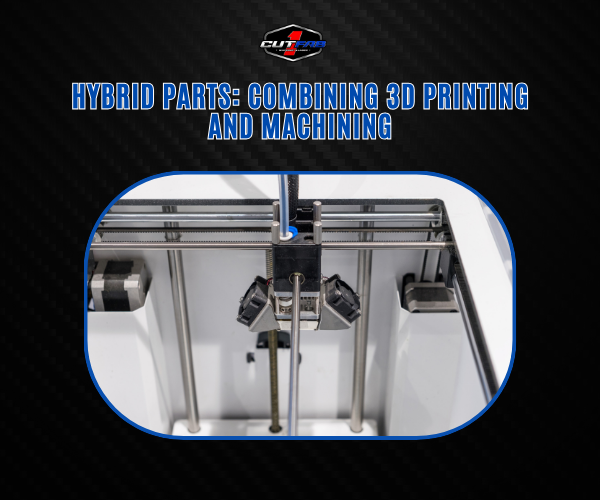
Hybrid Parts: Combining 3D Printing and Machining!
Hybrid manufacturing—often called hybrid 3D printing machining—is changing the way innovative products are built. This approach fuses additive manufacturing (3D printing) with traditional subtractive processes like CNC machining in a single workflow. The result? Complex geometries from 3D printing combined with the high precision and surface finish of machining.
Instead of choosing between speed or accuracy, manufacturers can leverage both. From aerospace components to custom medical devices, hybrid 3D printing machining delivers stronger parts, tighter tolerances, and faster production cycles. It’s a cutting-edge solution that reduces waste, shortens lead times, and sets a new standard for advanced fabrication.
Printing Near-Net Shapes for Machining
One of the most practical advantages of hybrid 3D printing machining is the ability to create near-net shapes—parts printed close to their final geometry so only minimal machining is needed. Instead of carving a component entirely out of a solid block of material, manufacturers use 3D printing to build the rough form layer by layer. This additive step drastically cuts down raw-material use, time on the CNC, and overall production costs.
Near-net shaping is especially powerful for complex or lightweight designs that would be wasteful—or nearly impossible—to machine from scratch. Aerospace brackets, turbine blades, and custom medical implants can be printed with internal cavities or lattice structures, then finished with precision machining for critical surfaces, tight tolerances, and perfect fit.
The hybrid workflow typically starts with a metal powder or filament that’s printed to just beyond the final dimensions. After printing, the part moves directly to CNC milling, turning, or grinding in the same machine or coordinated cell. This seamless transition eliminates multiple setups and reduces alignment errors, ensuring consistent accuracy.
By combining additive flexibility with subtractive precision, printing near-net shapes for machining turns material efficiency into a competitive edge—delivering stronger parts, faster turnaround, and lower production costs across industries.
Examples in Aerospace and Medical Applications
The aerospace and medical industries are leading adopters of hybrid 3D printing machining, leveraging its ability to create intricate, high-performance components with unmatched precision.
In aerospace, manufacturers print near-net titanium brackets, engine mounts, and turbine blades that would be prohibitively expensive to machine from a solid billet. Additive manufacturing forms lightweight lattice structures and complex internal channels for cooling or fluid flow, while CNC machining follows to achieve critical tolerances and smooth, aerodynamic surfaces. This combination reduces both material waste and overall aircraft weight—key factors for fuel efficiency and safety.
Medical device makers embrace the same approach for patient-specific implants, surgical instruments, and orthopedic components. Surgeons can receive custom titanium hip cups or cranial plates tailored to a patient’s anatomy, printed rapidly and then finish-machined for perfect fit and biocompatibility. Hybrid processes shorten lead times for life-saving devices and allow rapid design changes without sacrificing precision or regulatory compliance.
These real-world applications prove that integrating additive flexibility with subtractive accuracy isn’t just innovative—it’s commercially essential for industries where lightweight strength, tight tolerances, and reliable performance can’t be compromised.
CAD Considerations for Hybrid Processes
Designing for hybrid 3D printing machining starts long before the first layer is printed or the first toolpath is cut—it begins in CAD. Engineers must create models that balance the strengths of both additive and subtractive methods while anticipating how the part will transition between them.
First, designers should segment the model into areas best suited for 3D printing and those requiring machining. Features like internal lattices, undercuts, and organic geometries can be optimized for additive manufacturing, while critical interfaces, tight-tolerance bores, and smooth sealing surfaces should be reserved for machining. Properly tagging these zones in the CAD file ensures the hybrid machine knows when to print and when to cut.
Support structures and machining allowances also need careful planning. Adding a slight stock allowance—often 0.5–1 mm—around machined surfaces gives CNC tools room to achieve the final dimension. Fixturing considerations, such as orientation and clamping surfaces, must be integrated into the digital model to avoid costly repositioning later.
Finally, CAD data must remain compatible with both additive slicers and CAM software. High-resolution STL or STEP files with clear manufacturing notes streamline the workflow, reducing setup time and eliminating errors. Thoughtful CAD strategy turns a hybrid design into a seamless, cost-effective production reality.
Conclusion – When to Use Hybrid
Hybrid manufacturing—specifically hybrid 3D printing machining—is more than a trend; it’s a strategic advantage when used in the right scenarios. This approach shines when parts demand both the design freedom of additive manufacturing and the tight tolerances of precision machining.
Consider hybrid methods when material waste is a concern, such as with expensive metals like titanium or Inconel. Printing near-net shapes minimizes scrap while machining guarantees critical dimensions and surface finishes. It’s also ideal for complex geometries—internal channels, lattice structures, or intricate contours—that would be cost-prohibitive to produce solely with subtractive processes.
Industries like aerospace, medical, and high-performance automotive benefit most, where lightweight strength, rapid prototyping, and reliable repeatability are essential. Smaller shops can also leverage hybrid technology to shorten lead times and reduce the number of setups, gaining a competitive edge in custom or low-volume production.
By combining additive flexibility with subtractive accuracy, hybrid 3D printing machining empowers manufacturers to innovate faster, cut costs, and deliver parts that meet the highest standards of quality and performance.
